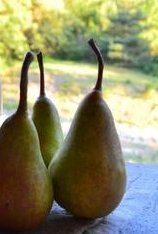How to Prune and Feed Neglected Pear Trees

Just moved into new home and found we have an old pear tree. It looks awful. How do we care for it? It also looks as if it has never been pruned.
***************************************************
We were in the same situation with our new farm this year, where we have a couple of neglected pear trees, apple trees and nearly 50 olive that hadn't been pruned for about 20 years! We were more ruthless with the abandoned olive trees, cutting them right down, and they have recovered beautifully so far.
With regards to old fruit trees, and in this case your pear tree, you have to give your tree a good once over to see if it is worth saving, or whether it would be better to rip it out and start again. Heartless, but possibly necessary.
Is your pear tree healthy? Are there any signs of problems with insects, disease that could spread to other trees, and is the tree trunk sound? If there are no problems then the tree is worth saving.
You don't say how tall the tree is, but wait until the winter, when the tree sap is dormant and the pear tree has lost all its leaves before doing any major pruning.
How to Prune Old, Neglected Pear Trees
In the first year you need to reduce the height of the tree if it is too tall to pick the fruit easily. Reducing the height by 1/3rd or more is acceptable. One pear tree here was about 20 foot in height and we lopped 8 foot off it. A little more than 1/3 in this case, but when you have taller trees, you can be more ruthless.
During this first year of hard pruning cut out any dead wood, any limbs that are crossing over each other and not allowing any light and air into the center of the tree. You also want to cut back the main side branches to be in proportion and balance with the rest of the pruning, and cut them back to a strong side shoot or riser.
In the second year, your pear tree will need further pruning. This can be done in the summer. Remove all the vigorously growing top shoots and leave just a few minor ones to grow to give the tree some shade. Any shoots that are coming off the trunk, or developing on the lower branches, leave these, as this is the growth that you are trying to encourage. You want the lower half of the tree to be more vigorous in growth than the top half.
During the winter of year two, you can further reduce the height of your pear tree, but no more than a foot or two. Any more than this and you will end up damaging the potential yield of your pear crop, or even damage the tree itself.
During the next growing season, continue to thin out the shoots coming from the top half of the canopy and allow those from the bottom to grow. Prune in a way that the shoots grow outwards, rather than upwards. Again, cut out any shoots that are crossing over to allow more light and air into the tree.
During the following year, continue to remove the new shoots from the top canopy, but this time, instead of removing almost all of them, remove only half of them.
During the following winter, cut back the side branches by about a foot and now shape your tree so that all your fruiting branches are evenly spaced over the whole of the tree, from the top to the bottom canopy.
If you need to reduce the side branches by 2 feet to do this, do it. Again, it just depends on how tall your tree is as to how much you will decided to remove.
You may still need a ladder to get to your fruit, but if you are really lucky, the tree will be at a height that allows you free access without a ladder.
Keep the tree lightly pruned for the following years, always removing some of the top vigorous growth, and not allowing it to get taller than you have it in your final year of hard pruning.
How to Feed Old, Neglected Pear Trees
Old, abandoned fruit trees are usually found with grass knee-high around the trunks, and choked with weeds. Remove all grass and weeds from under the tree, until where the branch tips end. This is known as the drip line.
Now get a garden fork and loosen the soil gently around the tree, right up to the drip line, making sure that you do not damage the roots. Get yourself some well-aged farm manure and spread this under the tree, and lightly fork it in.
You may have to add lime to the manure if your soil is very acidic. The ideal pH level for growing pear trees is 6.0-6.5.
I always advocate saving old fruit trees first, rather than replacing them with new trees.
First of all, if you are very lucky you may find that the variety of pear tree that you have is an heirloom variety that will give you far superior tasting fruit, than the wishy-washy modern varieties.
Secondly, once you have finished the 3 year pruning schedule, your tree will produce much more fruit than any new 4 year old pear tree would.
Regards
Kathryn
Comments for How to Prune and Feed Neglected Pear Trees
|
||
|
||
|
||
|
||
Did you find this page helpful?
Sharing is a way of saying, "Thanks!"
Follow Us and Keep Up to Date
Go back to the Home Page





